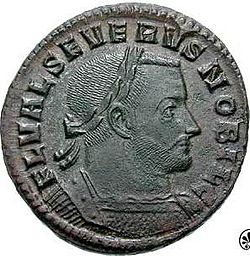Severus II
| Valerius Severus | |||||||||
|---|---|---|---|---|---|---|---|---|---|
 Coin from 305 or 306 depicting Severus | |||||||||
| Roman emperor | |||||||||
| Augustus | 25 July 306 – April 307 (in the West) | ||||||||
| Predecessor | Constantius I | ||||||||
| Successor | Maxentius, Licinius | ||||||||
| Co-rulers | Galerius (East) Constantine I (Gaul and Britain) Maxentius, and Maximian | ||||||||
| Caesar | 1 May 305 – 25 July 306 (in the West under Constantius) | ||||||||
| Born | c. 250 Illyria | ||||||||
| Died | September 307 Tres Tabernae | ||||||||
| Issue | Flavius Severianus | ||||||||
| |||||||||
Flavius Valerius Severus (c. 250 – September 307), also Severus II,[2] was a Roman emperor from 306 to 307. After failing to besiege Rome, he fled to Ravenna. It is thought that he was killed there or executed near Rome.
Background and early career
Severus was of humble birth, born in Northern Illyria (now Albania) around the middle of the third century AD.[3][4] He rose to become a senior officer in the Roman army,[3] and as an old friend of Galerius, that emperor ordered that Severus be appointed Caesar of the Western Roman Empire, a post that he succeeded to on 1 May 305.[5] He thus served as junior emperor to Constantius I (Constantius Chlorus), Augustus of the western half of empire.[3]
Augustus, 306–307
On the death of Constantius I in Britain in the summer of 306, Severus was promoted to Augustus by Galerius, in opposition to the acclamation of Constantine I (Constantius' son) by his own soldiers.[6][7] When Maxentius, the son of the retired emperor Maximian, revolted at Rome, Galerius sent Severus to suppress the rebellion. Severus moved towards Rome from his capital, Mediolanum, at the head of an army previously commanded by Maximian.[3] Fearing the arrival of Severus, Maxentius offered Maximian the co-rule of the empire. Maximian accepted, and when Severus arrived under the walls of Rome and besieged it, his men deserted to Maximian, their old commander. Severus fled to Ravenna, an impregnable position.[3] Maximian offered to spare his life and treat him humanely if he surrendered peaceably, which he did in March or April 307. Despite Maximian's assurance, Severus was nonetheless displayed as a captive and later imprisoned at Tres Tabernae.[3] One belief is that when Galerius himself invaded Italy to suppress Maxentius and Maximian, the former ordered Severus's death, and that he was executed (or forced to commit suicide) on September 307 at Tres Tabernae, near the current Cisterna di Latina.[4] Another belief is that Severus II was killed in Ravenna.[5][8]
Severus was survived by his son Flavius Severianus.
References
- ^ Cooley, Alison E. (2012). The Cambridge Manual of Latin Epigraphy. Cambridge University Press. p. 502. ISBN 978-0-521-84026-2.
- ^ Enumerated after Septimius Severus, skipping Severus Alexander.
- ^ a b c d e f Michael DiMalo (1998). "Severus II". An Online Encyclopedia of Roman Emperors. Retrieved 1 August 2015.
- ^ a b "Aurelius Victor, About Caesar" (in Russian). Ancient Rome. Retrieved 1 August 2015.
- ^ a b "Biography of Emperor Constantine" (in Russian). Ancient Rome. Retrieved 1 August 2015.
- ^ Barnes, Timothy David (1982). The New Empire of Diocletian and Constantine. Harvard University Press. pp. 26–27. ISBN 0-7837-2221-4.
- ^ Lactantius. "On the death of the persecutors". p. 5. Retrieved 1 August 2015.
- ^ Baronio, Annales Ecclesiastici, vol. 1, pp. 769-770
External links
 Works related to The History of the Decline and Fall of the Roman Empire, Volume 1, Chapter XIV at Wikisource
Works related to The History of the Decline and Fall of the Roman Empire, Volume 1, Chapter XIV at Wikisource Media related to Flavius Valerius Severus at Wikimedia Commons
Media related to Flavius Valerius Severus at Wikimedia Commons
